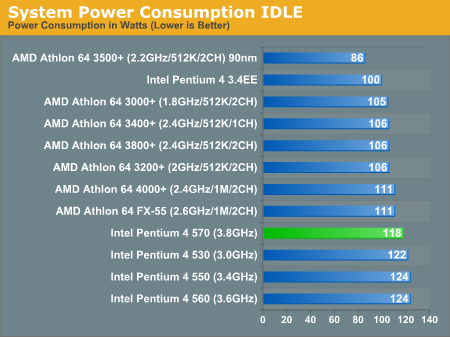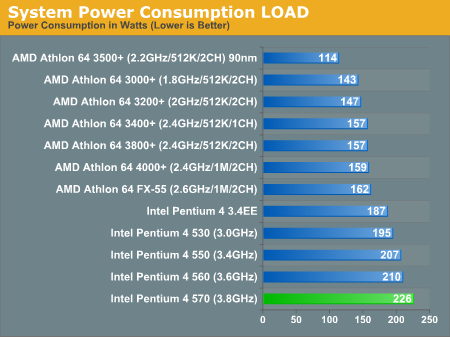Intel's Pentium 4 570J - Will 3.8GHz do the trick?
by Anand Lal Shimpi on November 14, 2004 10:56 AM EST- Posted in
- CPUs
Power Consumption
To measure power consumption we looked at overall system power consumption and tried to keep as many variables static. There are some basic differences which we cannot get around, mainly that the 925X uses lower voltage DDR-II while the nForce4 uses regular DDR, but for the most part our results were quite controlled. We also included power consumption figures from 130nm Socket-939 Athlon 64 3200+ and 3000+ chips, which as you may know, do not exist. The reason we did this was to show the sharp contrast to the power consumption figures of the 90nm 3500+ we've included in the charts below.
We measured power consumption in two states: idle sitting at the Windows desktop and under load while running our Windows Media Encoder 9 test, which proved to be one of the most strenuous CPU tests we ran as it pretty much isolated the CPU subsystem.
The Pentium 4 570J tops the charts as the heaviest power consumer out of our collection of CPUs here, which is no surprise. Since the 570J here is a different chip than the other Pentium 4s, its not too unsual to see slightly lower idle power consumption given that different chips in the Pentium 4 family can have different operating voltages.
We can't wait until AMD brings more of their Athlon 64 chips down to 90nm next year so that we may have an even cooler running Athlon 64 4000+.












42 Comments
View All Comments
Dustswirl - Sunday, November 14, 2004 - link
Aha! Thx guys!michaelpatrick33 - Sunday, November 14, 2004 - link
I meant #8 not #6 for the above post sorrymichaelpatrick33 - Sunday, November 14, 2004 - link
#6 You are right probably since they didn't mention 754 and that would give more parameters for the test. Good catch. They simply downclocked the 130nm 939 3500+.Glassmaster - Sunday, November 14, 2004 - link
#6: I'm pretty sure they downclocked a 130nm 939 3500+ for those measurements.Glassmaster.
Dustswirl - Sunday, November 14, 2004 - link
Quote:"[...]We also included power consumption figures from 130nm Socket-939 Athlon 64 3200+ and 3000+ chips, which as you may know, do not exist.[...]"
Mea culpa...
Dustswirl - Sunday, November 14, 2004 - link
Hmmmm so 2CH isn't like dual channel or? coz afaik 754 is single channel!Thx for the info :)
michaelpatrick33 - Sunday, November 14, 2004 - link
#4. They are using the 754 130nm core 3000+. That is why they say 90nm beside the 3500+ and not any of the other AMD64'sDustswirl - Sunday, November 14, 2004 - link
I don't understand how the A64 3500 90nm consumes less power then the A64 3000 (512/2CH) that is supposed to be also a 90nm part...michaelpatrick33 - Sunday, November 14, 2004 - link
The power consumption at load is a tad high for the 3.8 at being nearly twice as high as the 3500+. 226 vs. 114. That trend is obviously why Intel killed the 4.0 and beyond and the Tejas I would imagine. I wonder how much the 600 series chips from Intel will be with the extremely expensive L2 cache vs the current 3.6 and 3.8 chips.AtaStrumf - Sunday, November 14, 2004 - link
I've probably said this before, but I really like those tables with % numbers. You might wonna switch everything over to it. It gives a much more precise picture of diffence than those graphs.